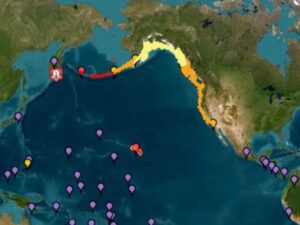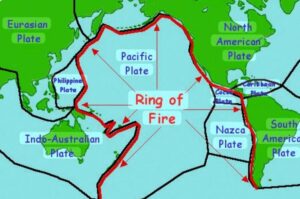Russian Earthquake Triggered Massive Tsunami : Russia, Japan, US on Alert
Russian Earthquake Triggered Massive Tsunami : 8.8 Magnitude Earthquake Russia’s far eastern Kamchatka Peninsula, Shakes Pacific Trench, Sparks Alerts from Russia to Hawaii, Japan of massive Tsunami waves.
Riot satsuki, also known as New Baba vanga of Japan has predicted a disaster will strike Japan in month of july , and this prediction is coming correct day by day.
What is the context about Russian Earthquake Triggered Massive Tsunami?
Massive Earthquake Strikes the Pacific Ocean and A powerful 8.8 magnitude earthquake struck beneath the Pacific Ocean near Russia’s far eastern Kamchatka Peninsula, early this morning, triggering fears of a potential tsunami across the region.
According to initial reports, tsunami waves were observed hitting Russia and parts of Japan, although the full extent of damage is still being assessed.

Image by: AFP
Tsunami Threat Resurfaces Memories of 2011 Fukushima Disaster…
This seismic event has raised deep concerns, particularly due to its similarities with the 2011 Tōhoku earthquake, which led to the devastating Fukushima nuclear crisis.
While the current quake’s magnitude is slightly lower than the 2011 event (which was 9.1), the tectonic setting is eerily similar.
The Kuril-Kamchatka Trench, where the Pacific Plate subducts beneath the Okhotsk Plate, was the epicenter for today’s quake—just like in past megathrust earthquakes.
Where the Earthquake Happened: Kuril-Kamchatka Region of Russian territory.
The quake occurred approximately 300 km southeast of Petropavlovsk, a key city on the Kamchatka Peninsula in Russia.
The region lies along the “Ring of Fire”, a seismically active zone surrounding the Pacific Ocean known for frequent quakes and volcanic activity.
The Kuril Islands, a disputed territory between Russia and Japan, lie near the epicenter.
What Causes This Russian Earthquake?
This was a megathrust earthquake, triggered when one tectonic plate is forced under another.
In this case, the Pacific Plate slid beneath the Okhotsk Plate, releasing massive amounts of energy.
Because the earthquake occurred at a relatively shallow depth of 25-30 km, the risk of a tsunami was significantly higher.
Tsunami Impacts: Russia, Japan, and Beyond
In Russia, tsunami waves of 3 to 4 metres were observed along the Kamchatka coast and Kuril Islands. Some port infrastructure has been damaged, and precautionary evacuations are underway.
In Japan, smaller tsunami waves of around 30 cm were reported, particularly in eastern regions like Hokkaido. Although there was no significant damage, authorities suspended train services as a precaution.
Tsunami alerts were also issued in parts of the United States, including Hawaii, California, and Alaska, but no major wave activity has been reported so far.
Russian Earthquake Triggered Massive Tsunami: Aftershocks and Ongoing Risk
Several aftershocks have followed, with one registering 6.0 on the Richter scale. Seismologists warn that more could follow in the coming days or weeks.
There’s also concern that today’s quake may not have released all the built-up energy, meaning a larger earthquake could still be possible in the near future.
Comparing 2025 vs 2011 Earthquake Events
Aspect of 2025 Earthquake details
- 8.8 Magnitude Scale
- Tsunami Height 3–4 m (Russia) 40 m (Japan)
Aspect of 2011 Fukushima Earthquake
- 9.1 Magnitude Scale
- Nuclear plant at Fukushima destroyed
- Casualties Not confirmed but over 18,000+
- Damage Under assessment $235 billion
Agencies like the US Geological Survey (USGS) and NOAA are continuously monitoring the region. Scientists have noted that only part of the fault line may have ruptured—meaning a second, possibly stronger quake is not out of the question.
Ring of Fire Still a Major Threat to Surrounding countries
The Pacific Ring of Fire, which includes the coasts of Russia, Japan, the US, and parts of South America and Australia, remains one of the world’s most volatile tectonic zones.
The Indian Ocean tsunami in 2004 and the Fukushima disaster in 2011 are grim reminders of the dangers these zones pose.
The 2025 quake is another warning that seismic preparedness must remain a top priority.

Public Safety and Emergency Measures amid Russian Earthquake
Emergency teams in Russia and Japan are on full alert. Early warnings and fast response likely helped prevent mass casualties this time.
However, concerns remain, especially in remote Russian coastal towns that may lack proper infrastructure or disaster readiness.The true scale of this disaster will become clear in the coming days.
For now, officials urge residents in coastal areas to stay alert, heed evacuation orders, and follow updates from national and international agencies.
